Geomorphodynamic Controls on the Distribution and Abundance of the Federally Threatened Puritan Tiger Beetle (Ellipsoptera puritana) Along the Maryland Chesapeake Bay Coast and Implications for Conservation
Abstract
1. Introduction
1.1. Background and Study Motivation
1.2. Geology of the Study Areas
1.2.1. Calvert County, Maryland
1.2.2. Sassafras River, Maryland
2. Materials and Methods
2.1. Adult PTB Surveys
2.2. Larval PTB Surveys
2.3. Habitat Studies
2.3.1. Photographic Vegetation Comparative Analysis
2.3.2. Field Data Collection and Parameter Determination
2.3.3. Data Analysis
3. Results
3.1. PTB Abundance and Density at All Sites
3.2. Potential and Probable Habitat
3.3. Bluff Parameters
3.4. Beach Parameters
3.5. Larval Surveys
3.6. Vegetation Comparison: 2000 and 2007
4. Discussion
5. Conclusions
Author Contributions
Funding
Data Availability Statement
Acknowledgments
Conflicts of Interest
Abbreviations
| ANOVA | Analysis of Variance |
| GIS | Geographic Information Systems |
| PTB | Puritan tiger beetle |
| PVA | Population Viability Analysis |
| SE | Standard error |
| USFWS | United States Fish and Wildlife Service |
| VWC | Volumetric water content |
References
- U.S. Fish and Wildlife Service (USFWS). Endangered and threatened wildlife and plants; determination of threatened status for Puritan Tiger Beetle and the Northeastern Beach Tiger Beetle. Fed. Regist. 1990, 55, 32088–32094. [Google Scholar]
- Omland, K.S. Puritan Tiger Beetle (Cicindela puritana) on the Connecticut River: Habitat management and translocation alternatives. In Species Conservation and Management: Case Studies; Akçakaya, H.R., Burgman, M.A., Kindvall, O., Wood, C.C., Sjögren-Gulve, P., Hatfield, J.S., McCarthy, M.A., Eds.; Oxford University Press: New York, NY, USA, 2004; pp. 137–149. [Google Scholar] [CrossRef]
- Knisley, C.B.; Gwiazdowski, R. Conservation strategies for protecting tiger beetles and their habitats in the United States: Studies with listed species (Coleoptera: Carabidae: Cicindelidae). Ann. Entomol. Soc. Am. 2021, 114, 293–301. [Google Scholar] [CrossRef]
- Pagac, B.B.; Ranum, K.L.; Knisley, C.B.; McCann, J.M.; Moser, G.A.; McGowan, P.C. Discovery of the Puritan Tiger Beetle, Ellipsoptera puritana (G. Horn) (Coleoptera: Carabidae), along the Severn River, Maryland. Coleopt. Bull. 2017, 71, 357–360. [Google Scholar] [CrossRef]
- U.S. Fish and Wildlife Service (USFWS). Puritan Tiger Beetle (Ellipsoptera puritana) 5-Year Review: Summary and Evaluation; U.S. Fish and Wildlife Service: Annapolis, MD, USA, 2025; 35p.
- Knisley, C.B. Studies of Cicindela puritana and C. d. dorsalis in Maryland, 2019; Unpublished report; Maryland Department of Natural Resources: Annapolis, MD, USA, 2019. [Google Scholar]
- Gowan, C.; Knisley, C.B. A population Viability Analysis for the Puritan Tiger Beetle in the Chesapeake Bay Region; U.S. Fish and Wildlife Service: Annapolis, MD, USA, 2016. [Google Scholar]
- Ashby, W.L. Fossils of Calvert Cliffs, 3rd ed.; Calvert Marine Museum: Solomons, MD, USA, 1995; 19p. [Google Scholar]
- Maryland Natural Heritage Program. Habitat Conservation Planning Assistance Grant Proposal; U.S. Fish and Wildlife Service, Region 5: Hadley, MA, USA, 2003. [Google Scholar]
- Vogler, A.P.; Knisley, C.B.; Glueck, S.B.; Hill, J.M.; Desalle, R. Using molecular and ecological data to diagnose endangered populations of the Puritan Tiger Beetle Cicindela puritana. Mol. Ecol. 1993, 2, 375–383. [Google Scholar] [CrossRef] [PubMed]
- Clark, I.; Larson, C.E.; Herzog, M. Evolution of equilibrium slopes at Calvert Cliffs, Maryland: A method of estimating the time scale of slope stabilization. Shore Beach 2004, 72, 17–23. [Google Scholar]
- Goetz, S.J.; Jantz, C.A.; Prince, S.D.; Smith, A.J.; Varlyguin, D.; Wright, R. Integrated analysis of ecosystem interactions with land use change: The Chesapeake Bay watershed. In Ecosystems and Land Use Change; Geophysical Monograph Series; DeFries, R.S., Ed.; AGU: Washington, DC, USA, 2004; Volume 153, pp. 263–275. [Google Scholar]
- Jantz, P.; Goetz, S.J.; Jantz, C.A. Urbanization and the loss of resource lands within the Chesapeake Bay watershed. Environ. Manag. 2005, 36, 808–825. [Google Scholar] [CrossRef]
- Bilkovic, D.M.; Roggero, M.M. Effects of coastal development on nearshore estuarine nekton communities. Mar. Ecol. Prog. Ser. 2008, 358, 27–39. [Google Scholar] [CrossRef]
- Goetz, S.J.; Jantz, P. Satellite maps show Chesapeake Bay urban development. Eos 2011, 87, 149–152. [Google Scholar] [CrossRef]
- Bilkovic, D.M.; Mitchell, M.M.; Havens, K.J.; Hershner, C.H. Chesapeake Bay. In World Seas: An Environmental Evaluation, 2nd ed.; Sheppard, C., Ed.; Academic Press: Cambridge, MA, USA, 2019; Volume I: Europe, the Americas and West Africa, pp. 379–404. [Google Scholar] [CrossRef]
- Knisley, C.B.; Schultz, T.D. The Biology of Tiger Beetles and a Guide to the Species of the South Atlantic States; Special Publication Number 5; Virginia Museum of Natural History: Martinsville, VA, USA, 1997. [Google Scholar]
- Hill, J.M.; Knisley, C.B. Puritan Tiger Beetle Recovery Plan; U.S. Fish and Wildlife Service, Northeast Region: Hadley, MA, USA, 1993. [Google Scholar]
- Omland, K.S. Larval habitat and reintroduction site selection for Cicindela puritana in Connecticut. Northeast. Nat. 2002, 9, 433–451. [Google Scholar] [CrossRef]
- Kidwell, S.M. Stratigraphic condensation of marine transgressive records: Origin of major shell deposits in the Miocene of Maryland. J. Geol. 1989, 97, 1–24. [Google Scholar] [CrossRef]
- Minard, J. Geology of the Betterton Quadrangle, Kent County, Maryland, and a discussion of the regional stratigraphy. In U.S. Geological Survey Professional Paper 816; U.S. Department of the Interior: Washington, DC, USA, 1974. [Google Scholar]
- Shattuck, G.B. The Miocene formations of Maryland. Science 1902, 15, 906. [Google Scholar]
- Shattuck, G.B. Geological and paleontological relations, with a review of earlier investigations. In The Miocene Deposits of Maryland; Clark, W.B., Shattuck, G.B., Dall, W.H., Eds.; Maryland Geological Survey: Baltimore, MD, USA, 1904; Volume 1, pp. xxxiii–cxxxvii. [Google Scholar]
- Ward, L.W. Molluscan biostratigraphy of the Miocene, Middle Atlantic Coastal Plain of North America. In Virginia Museum of Natural History Memoir Number 2; Virginia Museum of Natural History: Martinsville, VA, USA, 1992; 159p. [Google Scholar]
- Kidwell, S.M. Anatomy of extremely thin marine sequences landward of a passive-margin hinge zone: Neogene Calvert Cliffs succession, Maryland. J. Sediment. Res. 1997, 67B, 322–340. [Google Scholar] [CrossRef]
- Ward, L.W.; Powars, D.S. Tertiary lithology and paleontology, Chesapeake Bay region. In Geology of the National Capital Region—Field Trip Guidebook; Circular 1264; Southworth, S., Burton, W., Eds.; Geological Society of America: Boulder, CO, USA, 2004; pp. 263–297. [Google Scholar]
- International Union of Geological Sciences (IUGS); Geological Society of America (GSA). International Stratigraphic Guide: A Guide to Stratigraphic Classification, Terminology, and Procedure; Geological Society of America: Boulder, CO, USA, 2013. [Google Scholar]
- North American Commission on Stratigraphic Nomenclature (NACSN). North American Stratigraphic Code. Stratigraphy 2021, 18, 153–204. [Google Scholar] [CrossRef]
- Owens, J.P.; Minard, J.P.; Sohl, N.F.; Mello, J.E. Stratigraphy of the outcropping Post-Magothy Cretaceous formations in southern New Jersey and northern Delmarva Peninsula. In U.S. Geological Survey Paper 674; U.S. Government Printing Office: Washington, DC, USA, 1970; 59p. [Google Scholar]
- U.S. Fish and Wildlife Service (USFWS). Puritan Tiger Beetle (Cicindela puritana) 5-Year Review: Summary and Evaluation; U.S. Fish and Wildlife Service: Annapolis, MD, USA, 2019; 38p.
- Meyer, M.; Knisley, C.B. Studies of Ellipsoptera puritana and Habroscelimorpha d. dorsalis in Maryland, 2023; Report; Maryland Wildlife and Heritage Service: Annapolis, MD, USA, 2023; 31p. [Google Scholar]
- Knisley, C.B.; Hill, J.M. Studies of Cicindela dorsalis dorsalis and Cicindela puritana in Calvert, Cecil, and Kent Counties, Maryland: Site Surveys and Biological Studies; Final Report; Maryland Department of Natural Resources: Annapolis, MD, USA, 1993. [Google Scholar]
- Folk, R.L.; Ward, W.C. Brazos River bar: A study in the significance of grain size parameters. J. Sediment. Petrol. 1957, 27, 3–26. [Google Scholar] [CrossRef]
- Knisley, C.B.; Fenster, M.S. Studies of the Puritan Tiger Beetle (Cicindela puritana) and Its Habitat: Implications for Management; Final Report; U.S. Fish and Wildlife Service: Annapolis, MD, USA, 2009. [Google Scholar]
- Fenster, M.S.; Knisley, C.B. Impact of dams on point bar habitat: A case for the extirpation of the Sacramento Valley Tiger Beetle, Cicindela hirticollis abrupta. River Res. Appl. 2006, 22, 881–904. [Google Scholar] [CrossRef]
- Fenster, M.S.; Knisley, C.B.; Reed, C.T. Habitat preference and the effects of beach nourishment on the federally threatened Northeastern Beach Tiger Beetle, Cicindela dorsalis dorsalis: Western Shore, Chesapeake Bay, Virginia. J. Coast. Res. 2006, 22, 1133–1144. [Google Scholar] [CrossRef]
- Cornelisse, T.M.; Hafernik, J.E. Effects of soil characteristics and human disturbance on tiger beetle oviposition. Ecol. Entomol. 2009, 34, 495–503. [Google Scholar] [CrossRef]
- Leatherman, S.P. Cliff stability along western Chesapeake Bay, Maryland. Mar. Technol. Soc. J. 1986, 20, 28–36. [Google Scholar]
- Wilcock, P.R.; Miller, D.S.; Shea, R.H.; Kerkin, R.T. Frequency of effective wave activity and the recession of coastal bluffs: Calvert Cliffs, Maryland. J. Coast. Res. 1998, 14, 256–268. [Google Scholar]
- Hennessee, E.L.; Halka, J.P. Hurricane Isabel and erosion of Chesapeake Bay shorelines, Maryland. In Chesapeake Research Consortium Publication 05-160; Chesapeake Research Consortium: Edgewater, MD, USA, 2005; pp. 81–87. [Google Scholar]
- Callahan, J.A.; Leathers, D.J.; Callahan, C.L. Skew Surge and Storm Tides of Tropical Cyclones in the Delaware and Chesapeake Bays for 1980–2019. Front. Clim. 2021, 3, 610062. [Google Scholar] [CrossRef]
- Woodland, R.J.; Rowe, C.L.; Henry, P.F.P. Changes in habitat availability for multiple life stages of diamondback terrapins (Malaclemys terrapin) in Chesapeake Bay in response to sea-level rise. Estuaries Coasts 2017, 40, 1502–1515. [Google Scholar] [CrossRef]
- Fenster, M.S.; Knisley, C.B.; Gowan, C. Developing best management practices to enhance critical beach habitat for the northeastern beach tiger beetle (Habroscelimorpha dorsalis dorsalis) and human community resilience in the Chesapeake Bay (Virginia and Maryland). Part I: Effects of structures on Chesapeake Bay’s endangered beaches. In Technical Report Submitted to the National Fish and Wildlife Foundation; Technical Report; Randolph-Macon College: Ashland, VA, USA, 2025; EasyGrantsID: 76061. [Google Scholar]
- Volpano, A.; Zoet, L.K.; Rawling, J.E.; Theuerkauf, E.J.; Krueger, R. Three-dimensional bluff evolution in response to seasonal fluctuations in Great Lakes water levels. J. Great Lakes Res. 2020, 46, 1533–1543. [Google Scholar] [CrossRef]
- Zoet, L.K.; Rawling, J.E., III. Analysis of a sudden bluff failure along the southwest Lake Michigan shoreline. J. Great Lakes Res. 2017, 43, 999–1004. [Google Scholar] [CrossRef]
- Krueger, R.; Zoet, L.K.; Rawling, J.E., III. Coastal bluff evolution in response to a rapid rise in surface water level, 2020. J. Geophys. Res. Earth Surf. 2020, 125, e2019JF005428. [Google Scholar] [CrossRef]
- Gutierrez, B.T.; Williams, S.J.; Thieler, E.R. Potential for shoreline changes due to sea-level rise along the U.S. mid-Atlantic region. In USGS Open-File Report 2007-1278; U.S. Geological Survey: Reston, VA, USA, 2007; pp. 1–25. [Google Scholar] [CrossRef]
- Shultz, L.P.; Ashby, W. An analysis of an attempt to control beach erosion in the Chesapeake Bay, at Scientist Cliffs, Calvert County, Maryland. Chesapeake Sci. 1967, 8, 237–252. [Google Scholar] [CrossRef]
- Palmer, H.D. Shoreline erosion in Upper Chesapeake Bay: The role of groundwater. Shore Beach 1973, 41, 1–5. [Google Scholar]
- Knisley, C.B. Anthropogenic disturbances and rare tiger beetle habitats: Benefits, risks, and implications for conservation. Terrestr. Arthropod Rev. 2011, 4, 1–21. [Google Scholar] [CrossRef]
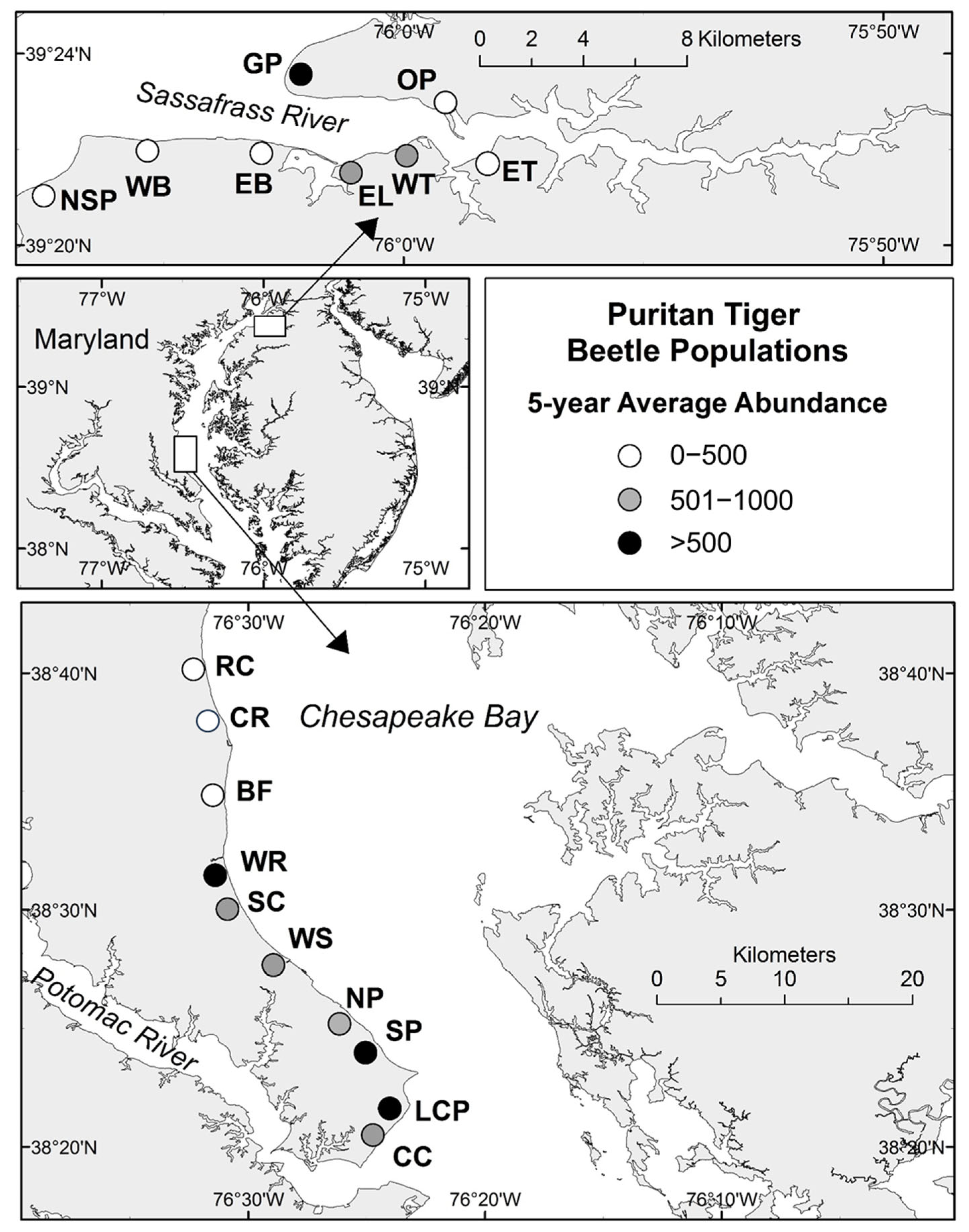
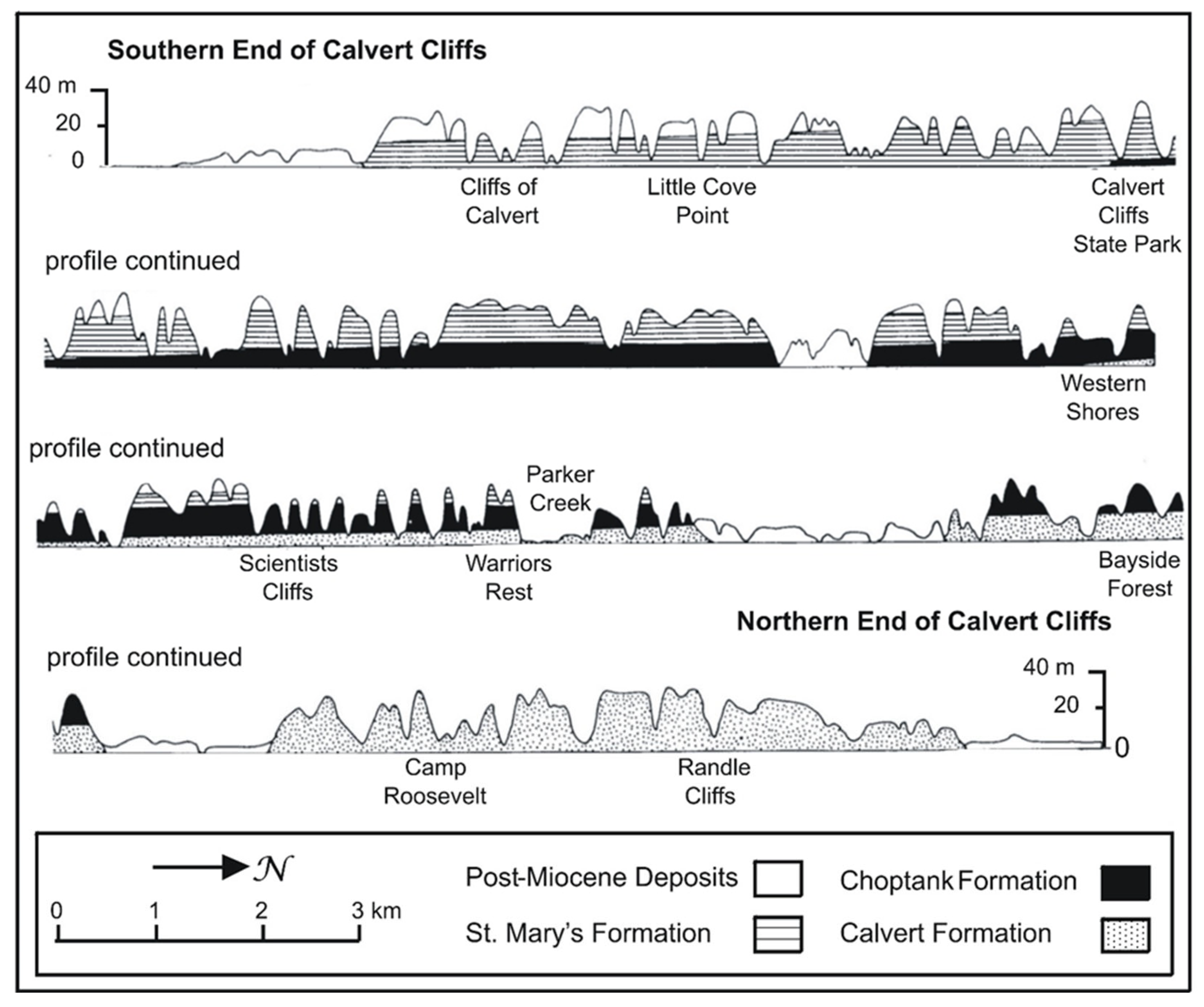


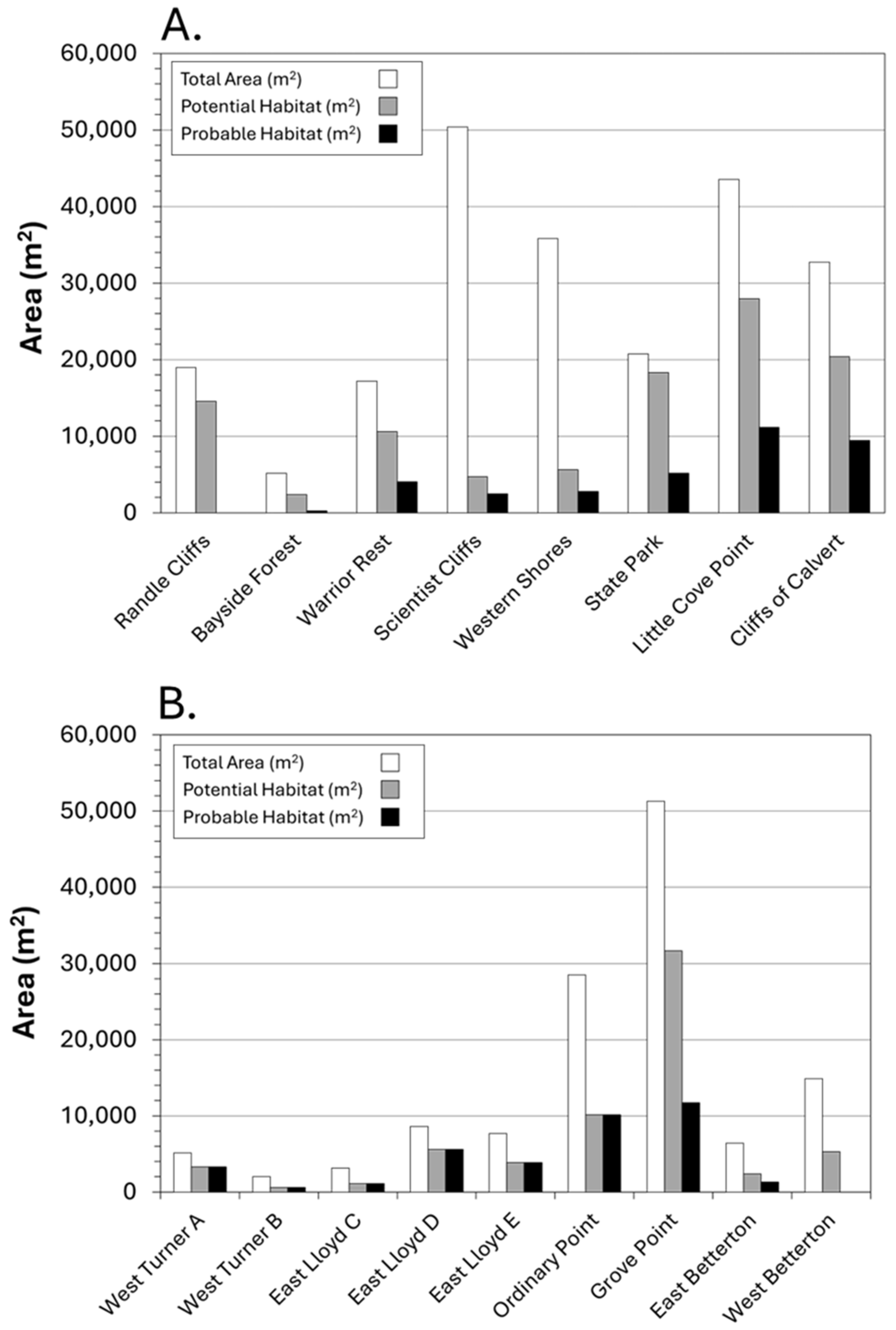


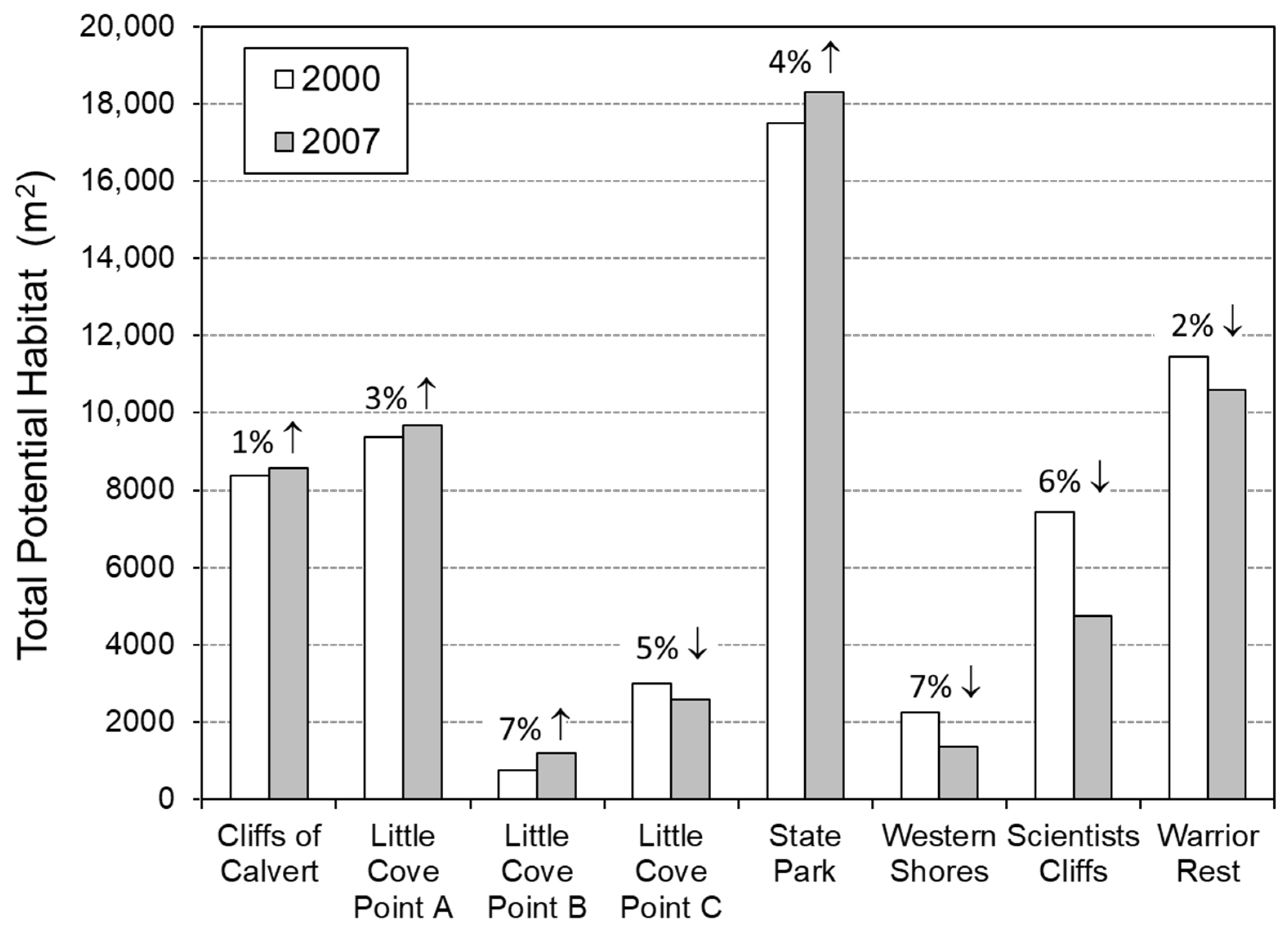
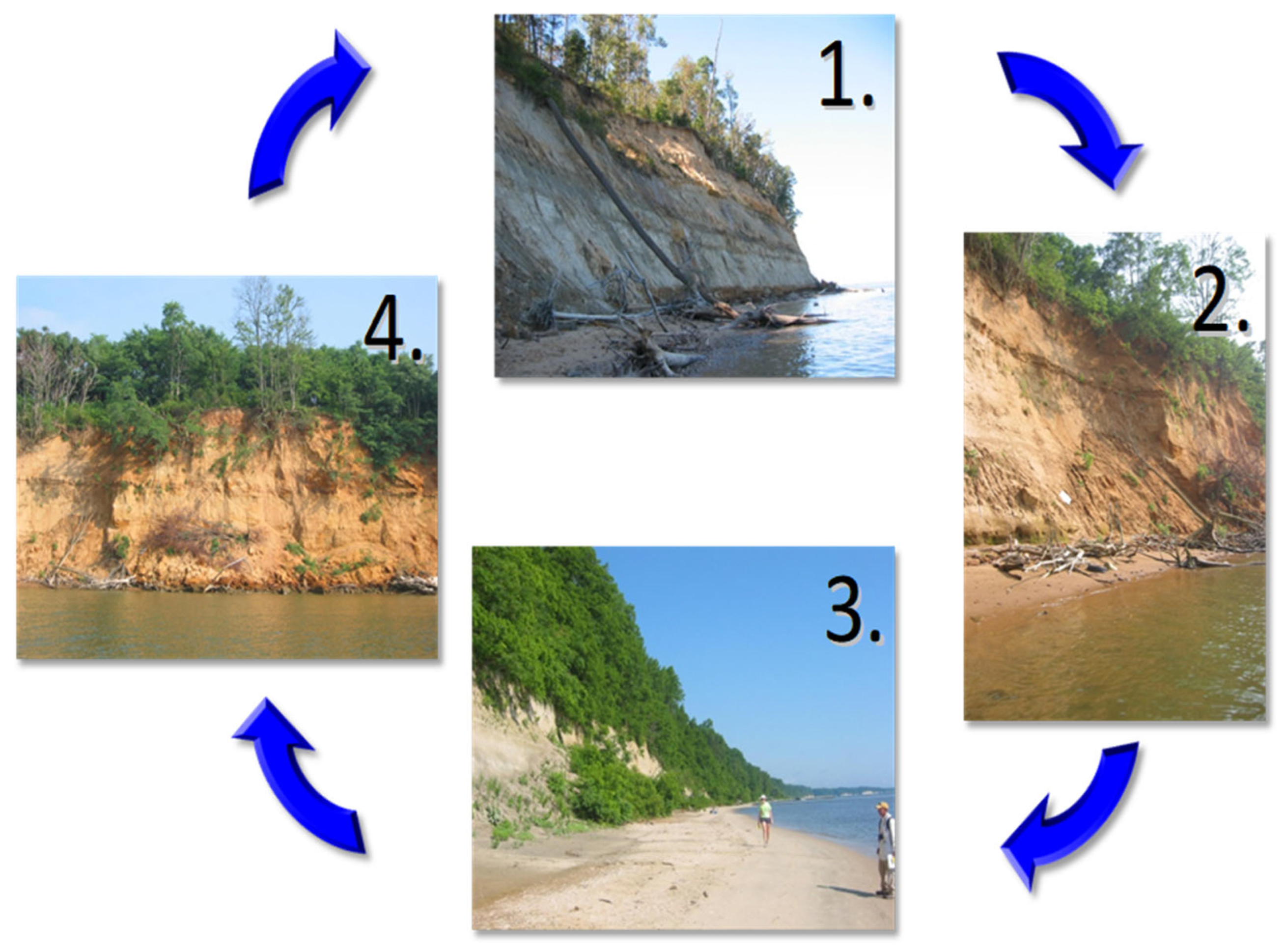


| Variable | Significance (p-Value) | High-Density Mean | SE | Low-Density Mean | SE |
|---|---|---|---|---|---|
| Moisture (% VWC) | 0.06 | 16.2 | 1.8 | 16.6 | 2.3 |
| Conductivity (dS/m) | 0.18 | 0.3 | 0.1 | 0.2 | 0.1 |
| Temperature (°C) | 0.33 | 27.6 | 1.5 | 25.6 | 2.3 |
| Compaction (psi) | 0.01 | 140.2 | 7.2 | 162.2 | 6.6 |
| Slope (°) | 0.35 | 64.1 | 2.7 | 63.3 | 3.8 |
| Mean grain size (mm) | 0.03 | 0.3 | 0.05 | 0.5 | 0.1 |
| Sorting (mm) | 0.03 | 0.2 | 0.03 | 0.5 | 0.1 |
| Percentage sand/mud (%) | 0.3 | 27.4 | 8.1 | 23.2 | 9.2 |
| Variable | Significance (p-Value) | High-Density Mean | SE | Low-Density Mean | SE |
|---|---|---|---|---|---|
| Width (m) | 0.76 | 5.0 | 0.3 | 4.8 | 0.6 |
| Beach cover (%) | 0.29 | 25.2 | 4.2 | 36.9 | 7.8 |
| Beach cover type | 0.65 | dead wood and vegetation | na | dead wood and vegetation | na |
| % shell and gravel | 0.74 | 11.6 | 1.6 | 12.6 | 3.3 |
| % heavy minerals | 0.67 | 1.3 | 0.5 | 1.6 | 0.8 |
| Shoreline orientation (°) | 0.64 | 277.5 | 38.7 | 215.1 | 55.7 |
| Slope at bluff toe (°) | 0.47 | 11.6 | 1.0 | 10.1 | 1.3 |
| Foreshore slope (°) | 0.38 | 7.6 | 0.7 | 8.6 | 1.0 |
| Mean grain size (mm) | 0.15 | 0.4 | 0.07 | 0.6 | 0.2 |
| Sorting (mm) | 0.47 | 0.3 | 0.08 | 0.4 | 0.1 |
| Number of Samples | Mean % Coarse | Range % Coarse | Mean % Medium | Range % Medium | Mean % Fine | Range % Fine | Mean % Clay | Range Clay % | |
|---|---|---|---|---|---|---|---|---|---|
| C. puritana | 17 | 22 | 4–64 | 38 | 11–66 | 36 | 7–61 | 5 | 0–15 |
| C. repanda | 22 | 26 | 4–86 | 26 | 6–54 | 26 | 6–62 | 22 | 1–71 |
| Both sp. | 9 | 23 | 4–64 | 39 | 14–48 | 35 | 7–62 | 3 | 0–15 |
Disclaimer/Publisher’s Note: The statements, opinions and data contained in all publications are solely those of the individual author(s) and contributor(s) and not of MDPI and/or the editor(s). MDPI and/or the editor(s) disclaim responsibility for any injury to people or property resulting from any ideas, methods, instructions or products referred to in the content. |
© 2025 by the authors. Licensee MDPI, Basel, Switzerland. This article is an open access article distributed under the terms and conditions of the Creative Commons Attribution (CC BY) license (https://creativecommons.org/licenses/by/4.0/).
Share and Cite
Fenster, M.S.; Knisley, C.B. Geomorphodynamic Controls on the Distribution and Abundance of the Federally Threatened Puritan Tiger Beetle (Ellipsoptera puritana) Along the Maryland Chesapeake Bay Coast and Implications for Conservation. Geosciences 2025, 15, 444. https://doi.org/10.3390/geosciences15120444
Fenster MS, Knisley CB. Geomorphodynamic Controls on the Distribution and Abundance of the Federally Threatened Puritan Tiger Beetle (Ellipsoptera puritana) Along the Maryland Chesapeake Bay Coast and Implications for Conservation. Geosciences. 2025; 15(12):444. https://doi.org/10.3390/geosciences15120444
Chicago/Turabian StyleFenster, Michael S., and C. Barry Knisley. 2025. "Geomorphodynamic Controls on the Distribution and Abundance of the Federally Threatened Puritan Tiger Beetle (Ellipsoptera puritana) Along the Maryland Chesapeake Bay Coast and Implications for Conservation" Geosciences 15, no. 12: 444. https://doi.org/10.3390/geosciences15120444
APA StyleFenster, M. S., & Knisley, C. B. (2025). Geomorphodynamic Controls on the Distribution and Abundance of the Federally Threatened Puritan Tiger Beetle (Ellipsoptera puritana) Along the Maryland Chesapeake Bay Coast and Implications for Conservation. Geosciences, 15(12), 444. https://doi.org/10.3390/geosciences15120444







